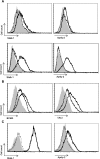Toll-Like Receptor 9 Stimulation Induces Aberrant Expression of a Proliferation-Inducing Ligand by Tonsillar Germinal Center B Cells in IgA Nephropathy
- PMID: 27920152
- PMCID: PMC5373453
- DOI: 10.1681/ASN.2016050496
Toll-Like Receptor 9 Stimulation Induces Aberrant Expression of a Proliferation-Inducing Ligand by Tonsillar Germinal Center B Cells in IgA Nephropathy
Abstract
The TNF family member a proliferation-inducing ligand (APRIL; also known as TNFSF13), produced by myeloid cells, participates in the generation and survival of antibody-producing plasma cells. We studied the potential role of APRIL in the pathogenesis of IgA nephropathy (IgAN). We found that a significant proportion of germinal centers (GCs) in tonsils of patients with IgAN contained cells aberrantly producing APRIL, contributing to an overall upregulation of tonsillar APRIL expression compared with that in tonsils of control patients with tonsillitis. In IgAN GC, antigen-experienced IgD-CD38+/-CD19+ B cells expressing a switched IgG/IgA B cell receptor produced APRIL. Notably, these GC B cells expressed mRNA encoding the common cleavable APRIL-α but also, the less frequent APRIL-δ/ζ mRNA, which encodes a protein that lacks a furin cleavage site and is, thus, the uncleavable membrane-bound form. Significant correlation between TLR9 and APRIL expression levels existed in tonsils from patients with IgAN. In vitro, repeated TLR9 stimulation induced APRIL expression in tonsillar B cells from control patients with tonsillitis. Clinically, aberrant APRIL expression in tonsillar GC correlated with greater proteinuria, and patients with IgAN and aberrant APRIL overexpression in tonsillar GC responded well to tonsillectomy, with parallel decreases in serum levels of galactose-deficient IgA1. Taken together, our data indicate that antibody disorders in IgAN associate with TLR9-induced aberrant expression of APRIL in tonsillar GC B cells.
Keywords: IgA nephropathy; cytokines; immunology.
Copyright © 2017 by the American Society of Nephrology.
Figures







Comment in
-
Glomerular disease: Role of tonsillar B cells in IgAN.Nat Rev Nephrol. 2017 Feb;13(2):63. doi: 10.1038/nrneph.2016.185. Epub 2016 Dec 19. Nat Rev Nephrol. 2017. PMID: 27990017 No abstract available.
Similar articles
-
A proliferation-inducing ligand (APRIL) induced hyper-production of IgA from tonsillar mononuclear cells in patients with IgA nephropathy.Cell Immunol. 2019 Jul;341:103925. doi: 10.1016/j.cellimm.2019.103925. Epub 2019 May 8. Cell Immunol. 2019. PMID: 31088610
-
Tonsillar TLR9 expression and efficacy of tonsillectomy with steroid pulse therapy in IgA nephropathy patients.Nephrol Dial Transplant. 2012 Mar;27(3):1090-7. doi: 10.1093/ndt/gfr403. Epub 2011 Jul 21. Nephrol Dial Transplant. 2012. PMID: 21778277
-
Increased APRIL Expression Induces IgA1 Aberrant Glycosylation in IgA Nephropathy.Medicine (Baltimore). 2016 Mar;95(11):e3099. doi: 10.1097/MD.0000000000003099. Medicine (Baltimore). 2016. PMID: 26986150 Free PMC article.
-
Relationship between tonsils and IgA nephropathy as well as indications of tonsillectomy.Kidney Int. 2004 Apr;65(4):1135-44. doi: 10.1111/j.1523-1755.2004.00486.x. Kidney Int. 2004. PMID: 15086452 Review.
-
New Insights and Future Perspectives of APRIL in IgA Nephropathy.Int J Mol Sci. 2024 Sep 26;25(19):10340. doi: 10.3390/ijms251910340. Int J Mol Sci. 2024. PMID: 39408691 Free PMC article. Review.
Cited by
-
IgA nephropathy: gut microbiome regulates the production of hypoglycosilated IgA1 via the TLR4 signaling pathway.Nephrol Dial Transplant. 2024 Sep 27;39(10):1624-1641. doi: 10.1093/ndt/gfae052. Nephrol Dial Transplant. 2024. PMID: 38402460 Free PMC article.
-
Serum BAFF levels are associated with the prognosis of idiopathic membranous nephropathy.Ren Fail. 2024 Dec;46(2):2391069. doi: 10.1080/0886022X.2024.2391069. Epub 2024 Aug 14. Ren Fail. 2024. PMID: 39143819 Free PMC article.
-
New Insights into the Pathogenesis and Treatment Strategies in IgA Nephropathy.Glomerular Dis. 2021 Oct 1;2(1):15-29. doi: 10.1159/000519973. eCollection 2022 Jan. Glomerular Dis. 2021. PMID: 36751267 Free PMC article. Review.
-
Safety, Tolerability, Pharmacokinetics, and Pharmacodynamics of VIS649 (Sibeprenlimab), an APRIL-Neutralizing IgG2 Monoclonal Antibody, in Healthy Volunteers.Kidney Int Rep. 2022 Feb 8;7(5):993-1003. doi: 10.1016/j.ekir.2022.01.1073. eCollection 2022 May. Kidney Int Rep. 2022. PMID: 35570983 Free PMC article.
-
Increased Abundance of Plasmacytoid Dendritic Cells and Interferon-Alpha Induces Plasma Cell Differentiation in Patients of IgA Nephropathy.Mediators Inflamm. 2017;2017:4532409. doi: 10.1155/2017/4532409. Epub 2017 Dec 18. Mediators Inflamm. 2017. PMID: 29403161 Free PMC article.
References
-
- Barratt J, Feehally J: IgA nephropathy. J Am Soc Nephrol 16: 2088–2097, 2005 - PubMed
-
- Appel GB, Waldman M: The IgA nephropathy treatment dilemma. Kidney Int 69: 1939–1944, 2006 - PubMed
-
- Suzuki Y, Suzuki H, Sato D, Kajiyama T, Okazaki K, Hashimoto A, Kihara M, Yamaji K, Satake K, Nakata J, Aizawa M, Novak J, Tomino Y: Reevaluation of the mucosa-bone marrow axis in IgA nephropathy with animal models. Adv Otorhinolaryngol 72: 64–67, 2011 - PubMed
-
- Suzuki Y, Tomino Y: Potential immunopathogenic role of the mucosa-bone marrow axis in IgA nephropathy: Insights from animal models. Semin Nephrol 28: 66–77, 2008 - PubMed
-
- Kokubo T, Hiki Y, Iwase H, Horii A, Tanaka A, Nishikido J, Hotta K, Kobayashi Y: Evidence for involvement of IgA1 hinge glycopeptide in the IgA1-IgA1 interaction in IgA nephropathy. J Am Soc Nephrol 8: 915–919, 1997 - PubMed
MeSH terms
Substances
LinkOut - more resources
Full Text Sources
Other Literature Sources
Research Materials
Miscellaneous

